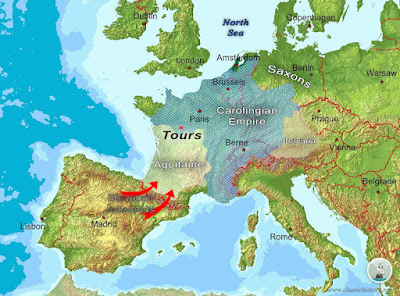Just because Charlemagne was married doesn't mean he didn't also have concubines. Charlemagne's biographer Einhard describes four concubines whom he says the king took
after the death of his last wife, but Einhard was determined to praise his subject. Wetti of Reichenau, on the other hand, refers to Charlemagne's "undiminished and extramarital sexual energy." There seems to be evidence of births, however, that suggests he maintained concubines during his marriage to
Hildegarde.
Gersuinda, described by Einhard as a Saxon, gave him a daughter, Adaltrude, born in 774, and then largely disappeared from history.
Madelgard produced a daughter in 775, Ruodhaid, who became abbess of Faremoutiers from 840 to 852, a Merovingian Benedictine nunnery that was a common destination for Carolingian royalty.
After Hildegarde's death in 783, Charlemagne married Fastrada in October of that same year. Fastrada's father was Count Rudolph of the East Franks, and the political advantage of this marriage was an alliance with lands east of the Rhine where Saxons were a problem for the Franks. Fastrada was considered cruel by Einhard (who, to be fair, did not come to Charlemagne's court until after Fastrada was out of the picture). When Charlemagne's oldest son, Pepin the Hunchback (by his first concubine, Himiltrude), tried to rebel unsuccessfully against his father, supposedly it was Fastrada who ordered him to be humiliated by being publicly tonsured.
Fastrada bore two daughters, Hiltrude and Theodrada, who became the abbess of the monastery at Argenteuil. Argenteuil had been connected to St. Denis, but a record in 828 states that Argenteuil became independent when Charlemagne gave her the position, but that Theodrada wanted it to go back under St. Denis, so long as Theodrada were allowed to live there for life.
Fastrada died on 10 August 794 in Frankfurt, where she had traveled with her husband for the Synod of Frankfurt. She was buried in St. Alban's Abbey in a tomb of white marble, but her tomb today can be seen in Mainz Cathedral where it had been transferred after the destruction of St. Albans in 1552.
Fastrada appears in the musical Pippin, a fictional version of the life of Pepin the Hunchback, about whom I have lots more to tell you, but that will have to come after one more wife and a couple more concubines. Stay tuned.














